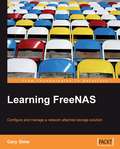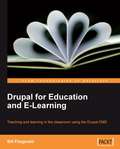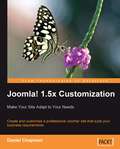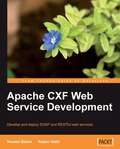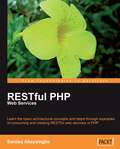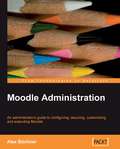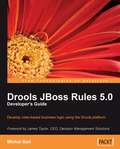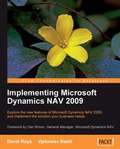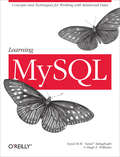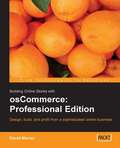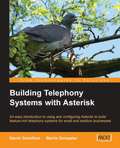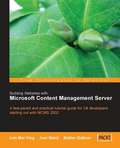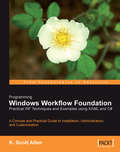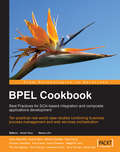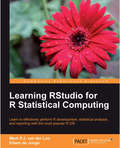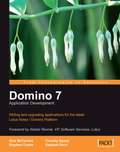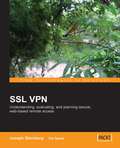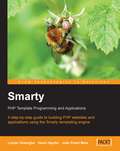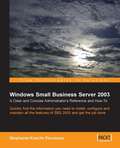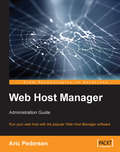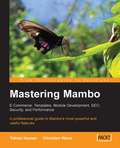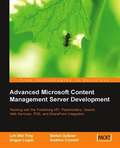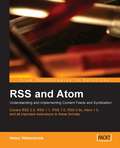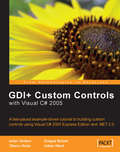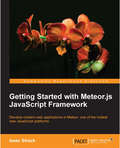- Table View
- List View
Learning FreeNAS
by Gary SimsThis book has been written from the system administrator's perspective, tackling the topics that will be most important to help you understand FreeNAS, and get it set up as securely and quickly as possible. You will just see how to get the job done. This book is for systems administrators who want a low cost, simple way to provide large amounts of network-attached storage. It does not assume knowledge of BSD, and will work for people using FreeNAS in any network environment.
Drupal for Education and E-Learning
by Bill FitzgeraldThe book focuses around creating educational activities in Drupal, with lots of examples of realistic courses and classroom ideas and how to implement them. This book is for anybody looking to use Drupal to support teaching and learning; more generally, the examples given in this book can also be used by anybody looking to use Drupal to publish social media. This book is not a developer's manual; you do NOT need to know code, or HTML, or CSS, to benefit from this book. People new to Drupal will find clear examples describing how to set up their site. More experienced Drupallers will find tips and tricks for extending their site, and step-by-step instructions on how to make the most out of Drupal's flexibility.
Joomla! 1.5x Customization: Make Your Site Adapt to Your Needs
by Daniel ChapmanFilled with plenty of examples and careful explanations, this step-by-step guide teaches you to build a subscription-based business site with Joomla!. This site will evolve chapter by chapter as you apply the techniques and theory that you are learning to it. You will start by looking at the environment in which you develop, setting yourself up with the right tools to develop a professional site as effectively and efficiently as possible. Then you will move on to setting the purpose of our site, and why it is important to have a clear purpose and goals for your site before you ever even install Joomla!. You will begin to look through choosing, installing and customizing extensions, and proceed to work on your sample subscription site as a practical example of the information covered in each chapter. Finally you will look at how to market and monetize your site to ensure the maximum success for your site. This book is written for people with basic knowledge of Joomla! who want to expand their skills and move from simply assembling extensions and installing a template to truly customizing their own site. Readers are expected to have functional knowledge of Joomla! and a very basic understanding of terms such as FTP, PHP, HTML, CSS, JavaScript, even if they have no real knowledge of the workings behind these terms. This book does not cover topics such as installing Joomla! and extensions, or creating content. The ideal reader is one who wishes to build a successful business web site using Joomla! and is interested in making as well as saving money by applying professional tools and techniques to the development, monetization, and marketing of their site. Non-business focussed site owners can still benefit greatly from the book, however, if they wish to add a level of professionalism to their work.
Apache CXF Web Service Development
by Rajeev Hathi Naveen BalaniThis book provides a quick start in developing web services using the open source Apache CXF framework. Each chapter uses illustrations from an Order Processing Application and all the code examples are built using the ANT tool. These practical, simple, and easy-to-work-with illustrations are accompanied by step-by-step instructions. As a developer you can take advantage of these practical scenarios to understand the CXF framework and also make use of them in real-life applications. After reading this book, you will be able to develop and deploy services using the CXF framework. This book is for developers who want to design and develop SOAP and RESTful services using Apache CXF framework and leverage various CXF features for service development. It is ideal for developers who have some experience in Java application development as well as some basic knowledge of web services, but it covers some of the basic fundamentals of web services and REST to get you acquainted with these technologies before using these concepts to develop services using the CXF framework.
RESTful PHP Web Services
by Samisa AbeysingheThe book explains the basic concepts associated with the REST architectural style, but the emphasis is on creating PHP code for consuming and creating RESTful services in PHP. There is plenty of example PHP code to illustrate the concepts, with careful explanations of how the code works. This book targets PHP developers who want to build or make use of RESTful web services, or explore the options available to them in PHP. You will need to know the basics of PHP development, but no knowledge of REST is assumed, nor any knowledge of creating web services generally.
Moodle Administration
by Alex BuchnerWritten in a clear, straightforward way with lots of screenshots and direct instructions this book will equip you with all the tools you need to set up, optimize, extend, and maintain a Moodle system. A problem-solution approach has been taken when possible to bring the content more in line with your day-to-day operations. This book is written for technicians, systems administrators, as well as academic staffâ "basically anyone who has to administer a Moodle system. Whether you are dealing with a small-scale local Moodle system or a large-scale multi-site Virtual Learning Environment, this book will assist you with any administrative tasks. Some basic Moodle knowledge is helpful, but not essential.
Drools JBoss Rules 5.X Developer’s Guide
by Michal BaliThe chapters in the book present real-life examples, usually starting with an introduction to the problem, and a discussion of the possible solution. Then the solution is implemented in a step by step fashion implementing several rules.The book is for Java developers who want to create rule-based business logic using the Drools platform.
Implementing Microsoft Dynamics NAV 2009
by Vjekoslav Babi David RoysWritten in an easy-to-read style, this book is a refreshing alternative to the official Microsoft training and reference material which, although comprehensive, can sometimes be tiring to read. This is not a reference book, although you may find you refer to it often, giving you access to years of experience in implementing and programming Dynamics NAV. You will learn all the new features in NAV 2009, without needing to invest significant study time.Dynamics NAV implementation consultants and developers that want to quickly understand the new features offered in the 2009 release.NAV consultants that want to learn more about programming and extensibility without needing to learn a programming language will also benefit from this book.NAV programmers that want to learn about finance configuration and solution design in order to be a better programmer and design better solutions can also use this book.
Learning MySQL
by Hugh E. Williams Seyed M.M. TahaghoghiWhether you're running a business, keeping track of members and meetings for a club, or just trying to organize a large and diverse collection of information, you'll find the MySQL database engine useful for answering questions such as: Which are my top ten fastest-selling products? How frequently does this person come to our facility? What was the highest, lowest, and average score of the team last season?MySQL, the most popular open-source database, offers the power of a relational database in a package that's easy to set up and administer, and Learning MySQL provides all the tools you need to get started. This densely packed tutorial includes detailed instructions to help you set up and design an effective database, create powerful queries using SQL, configure MySQL for improved security, and squeeze information out of your data. After covering the basics, the book travels far into MySQL's subtleties, including complex queries and joins, how to interact with the database over the Web using PHP or Perl, and important house-keeping such as backups and security.Topic include: Installation on Linux, Windows, and Mac OS X Basic and advanced querying using SQL User management and security Backups and recovery Tuning for improved efficiency Developing command-line and web database applications using the PHP and Perl programming languagesThe authors, Saied Tahaghoghi and Hugh E. Williams, have careers in academia and business, and share a keen interest in research into search technologies.Whether you've never touched a database or have already completed some MySQL projects, you'll find insights in Learning MySQL that will last a career.
Building Online Stores with osCommerce: Professional Edition
by David MercerThis book is written for anyone who: Already uses OSCommerce, Would like to use OSCommerce, Would like to make a website for their business, Is charged with administering, running and maintaining an OSCommerce site, Is interested in learning how an eCommerce application is created and maintained
Building Telephony Systems With Asterisk
by Barrie Dempster David GomillionThis book is aimed at anyone who is interested in building a powerful telephony system using the free and open source application, Asterisk, without spending many thousands of dollars buying a commercial and often less flexible system. This book is suitable for the novice and those new to Asterisk and telephony. Telephony or Linux experience will be helpful, but not required.
Building Websites with Microsoft Content Management Server
by Lim Ying Joel WardYears of active participation in MCMS newsgroups and mailing lists mean that the authors? hard-won experience puts them in the ideal position to tell you what you really need to know to master the system.An example site is developed throughout the book, at every point providing clear and practical demonstrations of the relevant ideas. Once you have mastered the basics, the book leads you onto more advanced and powerful techniques, allowing you to get the most from this awesome system.This book is written for developers who are part of a dynamic organization that has decided to evaluate or deploy MCMS and require the skills to make it happen.The book presumes a working knowledge of the .NET Framework and familiarity with the C# language, but no prior knowledge of MCMS is required. To use this book, you will need access to Visual Studio. NET 2002 or 2003, SQL Server 2000, and an installation of MCMS 2002.This book is not aimed at the specific information needs of administrators or users of MCMS.
Programming Windows Workflow Foundation: Practical WF Techniques and Examples using XAML and C#
by K. AllenFast-paced and to-the-point, this book takes you through the important topics of Windows WF development with clear explanations and practical example code. The book's selection of topics is driven by what the working developer needs to know. It is neither a comprehensive reference to the whole WF architecture, nor a strategy guide to the complete application development lifecycle. It's just what you as a C# developer need to know to use WF in your applications. This book is for .NET developers who want to enhance their applications with flexible workflow capabilities using Microsoft Windows Workflow Foundation. The author assumes that you have read other texts on the overall architecture of WF and on WF application design strategies, and instead focuses on real-work implementation issues for C# developers.
BPEL Cookbook: Best Practices for SOA-based integration and composite applications development
by Doug Todd Arun PoduvalThis book is aimed at architects and developers building applications in Service Oriented Architecture. The book presumes knowledge of BPEL, SOA, XML, web services, and multi-tier architectures.
Learning RStudio for R Statistical Computing
by Edwin De Jonge Mark Van LooA practical tutorial covering how to leverage RStudio functionality to effectively perform R Development, analysis, and reporting with RStudio. The book is aimed at R developers and analysts who wish to do R statistical development while taking advantage of RStudio functionality to ease their development efforts. Familiarity with R is assumed. Those who want to get started with R development using RStudio will also find the book useful. Even if you already use R but want to create reproducible statistical analysis projects or extend R with self-written packages, this book shows how to quickly achieve this using RStudio.
Domino 7 Lotus Notes Application Development
by Tim Speed Dick MccarrickEstablished Notes/Domino industry experts teach you how to harness the powerful new features available in Lotus Notes/Domino version 7 to develop robust business applications. Developers who work with Lotus technologies, and need to get to grips with the new developer features provided in version 7.
SSL VPN: Understanding, evaluating and planning secure, web-based remote access
by Joseph SteinbergThe book blends technically rigorous descriptions with a friendly approach based on practical examples and scenarios. The authors write in clear, informal language and make extensive use of diagrams and images. The book begins with an overview of SSL VPN?s purpose, and the technical and business trends that are making it popular today. It then looks at how SSL VPNs work and how they fit into existing network plans. The effect of SSL VPN on the wider business environment is then considered, before looking at how SSL VPN technology is likely to develop in the future. This book aimed at IT network professionals and managers who are currently evaluating SSL VPN technologies. It requires a broad understanding of networking concepts, but does not require specific and detailed technical knowledge of protocols or vendor implementations.
Smarty PHP Template Programming and Applications
by Joao Prado Maia Hasin HayderUsing a step-by-step approach based on realistic examples, the expert authors show you how to use Smarty in your own PHP development. This book is written for PHP developers who want to use Smarty templates in their development, and for designers who are working with PHP developers who are using Smarty.
Windows Small Business Server SBS 2003: A Clear and Concise Administrator's Reference and How-To
by Stephanie Knecht-ThurmannThis book is the perfect complement to Microsoft�??s exhaustive and exhausting official documentation. In one focused volume all the common tasks are explained and step by step intructions provided. The emphasis is on solving problems quickly and effectively without having to rake over the knowledge bases or trawl through pages of side chat. Any underlying technology and structure issues are explained at the right level of detail to ground actions in understanding. This book is the perfect complement to Microsofts exhaustive and exhausting official documentation. In one focused volume all the common tasks are explained and step by step intructions provided. The emphasis is on solving problems quickly and effectively without having to rake over the knowledge bases or trawl through pages of side chat. Any underlying technology and structure issues are explained at the right level of detail to ground actions in understanding.
Web Host Manager Administration Guide
by Aric PedersenConcise, well organized style means you will be able to refer back to this book again and again Frequent screenshots and clear explanations throughout Highly practical, with frequent step by step instructions for the most useful processes and tasks An Administrator's Guide to WHM is designed for new server administrators and professionals who are new to working with WHM. Even if you've never had experience working with Linux servers before this book will walk you through every feature available so you'll be comfortable with WHM in no time. The book also provides tips and tricks that you will be using for years to come.
Mastering Mambo: E-Commerce, Templates, Module Development, SEO, Security, and Performance
by Christian Wenz Tobias HauserUsing a highly graphical, practical style the experienced authors show you how to get the most out of Mambo's more advanced features and abilities. Mastering Mambo is the book for anybody who has developed a Mambo web site, and wants to expand what their site can do and make the most of this powerful content management system. It is not a tutorial in the Mambo basics. Nor is it a comprehensive reference to Mambo's workings. Instead, it shows you how to employ Mambo's most powerful and useful features in your own site or intranet.
Advanced Microsoft Content Management Server Development
by Andrew Connell Angus LoganThis book is written for developers who want to the skills to fully exploit the power of MCMS and SPS. The book presumes a working knowledge of MCMS, the .NET Framework and familiarity with the C# language. All the code examples are in C#.
RSS and Atom: Understanding and Implementing Content Feeds and Syndication
by Heinz WittenbrinkThe style of the book is succinct and precise. The information is densely packed but well structured, making it both readable as an introduction and overview, but also highly functional as a reference. The author is authoritative but friendly in his style, and peppers the text with interesting examples and pertinent URLs. This book has been written for content professionals, web developers and marketing teams who want to understand what RSS and content syndication is, how it works, what it can for them, and how they can get it up and running. It assumes a solid knowledge of XML and how the web works, but is not intended to be the exclusive province of the technically minded.
GDI+ Application Custom Controls with Visual C# 2005
by Adam Ward Dragos BrezoiThroughout the book the emphasis is on using examples to illustrate concepts and techniques. Code is shown in detail, and explained thoroughly. The examples themselves are intended to be both intructional and useful in their own right. This book has been written with the intermediate C# developer in mind. Assuming a working knowledge of C#, the book teaches you how to implement custom controls using Visual C# 2005 Express Edition and all other versions of Visual C#, and GDI+ with .NET 2.0
Getting Started with Meteor.js JavaScript Framework
by Isaac StrackWritten in an engaging, easy-to-follow style, "Getting Started with Meteor" is a practical guide for developing modern web applications with Meteor. This book is for developers or students who have a working knowledge of JavaScript and HTML, and want to learn how to quickly develop web applications using pure JavaScript. A basic understanding of traditional web server development and database methodologies will be helpful, but not necessary. Readers are expected to know how to program basic HTML pages and JavaScript functions, and be familiar with Terminal (basic Shell) commands.
